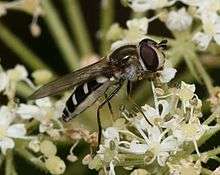Melangyna umbellatarum
Melangyna umbellatarum is a Holarctic species of hoverfly.[1][2][3][4]
| Melangyna umbellatarum | |
|---|---|
| Melangyna umbellatarum. Male | |
 | |
| Female, side view | |
| Scientific classification | |
| Kingdom: | |
| Phylum: | |
| Class: | |
| Order: | |
| Family: | |
| Genus: | |
| Species: | M. umbellatarum |
| Binomial name | |
| Melangyna umbellatarum (Fabricius, 1794) | |
| Synonyms | |
|
| |
Description
External images For terms, see: Morphology of Diptera.
Wing length: 6.5–8.75 mm (0.256–0.344 in). This species closely resembles Melangyna ericarum, but the thorax has pale hairs on the disc (many black hairs in M. ericarum). The jowls have only pale hairs below the eyes, whereas M. ericarum has some black hairs. Tergite 2 has moderately large, yellow side-spots which extend close to or over the side-margins of the tergite (they are widely set back from it in M. ericarum). The legs have distinct clear orange markings (obscure in M. ericarum), and the four anterior femora have few or none of the posterior black bristles present in M. ericarum.[5] For full characters and references, see Bartsch et al.[6] and Bei-Bienko, G.Y. & Steyskal, G.C.[7][8] The male terminalia are figured by Hippa.[9]
Distribution
Palearctic: Fennoscandia south to Iberia, Ireland east through North Europe, Central Europe and South Europe then east into European Russia and Siberia to Kamchatka. Nearctic: Alaska to Arizona (records may be referable to M. fisherii (Walton). [10][11][12]
Biology
Habitat: streams with Salix, Salix carr, beside streams and rivers fringed by Salix.[13] Flowers visited include white umbellifers, Foeniculum, Euphorbia, Filipendula ulmaria, Sorbus.[14] The flight period is May to September.Larvae predate aphids.
References
- Stubbs, Alan E.; Falk, Steven J. (1983). British Hoverflies: An Illustrated Identification Guide (2nd ed.). London: British Entomological and Natural History Society. pp. 253, xvpp. ISBN 1-899935-03-7.
- Ball, S.G.; Morris, R.K.A. (2000). Provisional atlas of British hoverflies (Diptera, Syrphidae). Monks Wood, UK: Biological Record Centre. 167 pages. ISBN 1-870393-54-6.
- Van Veen, M.P. (2004). Hoverflies of Northwest Europe, Identification Keys to the Syrphidae (Hardback). Utrecht: KNNV Publishing. p. 254. ISBN 90-5011-199-8.
- Fauna Europaea.
- Coe, R.L. (1953). "Diptera: Syrphidae". Handbks. ident. Br. insects 10(1): 1-98. R. ent. Soc. London.
- Bartsch, H., Binkiewicz, E., Rådén, A. & Nasibov, E. 2009 Nationalnyckeln till Sveriges flora och flora. Tvåvingar: Blomflugor: Syrphinae. Diptera:Syrphidae: Syrphinae. ArtDatabanken, SLU, Uppsala. 406 pp.
- Bei-Bienko, G.Y. & Steyskal, G.C. (1988) Keys to the Insects of the European Part of the USSR, Volume V: Diptera and Siphonaptera, Part I. Amerind Publishing Co., New Delhi. ISBN 81-205-0080-6.
- Speight, M.C.D. (1988). "Syrphidae known from temperate Western Europe: potential additions to the fauna of Great Britain and Ireland and a provisional species list for N. France". Dipterists Digest 1: 2-35.
- Hippa, H. (1968b). "A generic revision of the genus Syrphus and allied genera (Diptera: Syrphidae) in the Palearctic region, with descriptions of the male genitalia". Acta Ent. Fenn 25: 1-94.
- Fauna Europaea
- Peck, L.V. (1988). "Syrphidae". In: Soos, A. & Papp, L. (eds.). Catalogue of Palaearctic Diptera 8: 11-230. Akad. Kiado, Budapest.
- Vockeroth, J.R. (1992). The Flower Flies of the Subfamily Syrphinae of Canada, Alaska, and Greenland (Diptera: Syrphidae). Part 18. The Insects and Arachnids of Canada. Ottawa, Ontario: Canadian Government Pub Centre. pp. 1–456. ISBN 0-660-13830-1.
- Speight, M.C.D. (2011). "Species accounts of European Syrphidae (Diptera)" (PDF). Syrph the Net, the database of European Syrphidae. 65: 285pp.
- de Buck, N. (1990). "Bloembezoek en bestuivingsecologie van Zweefvliegen (Diptera, Syrphidae) in het bijzonder voor België". Doc. Trav. IRSNB, no. 60, pp. 1-167.